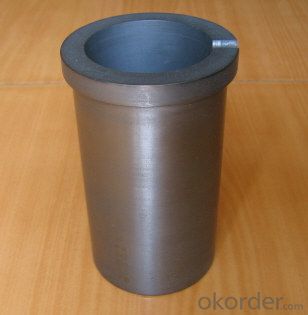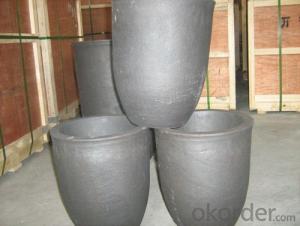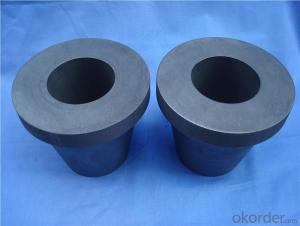Ceramic Graphite Crucibles/CNBM Ceramic Crucibles For Melt Aluminum
- Loading Port:
- China main port
- Payment Terms:
- TT OR LC
- Min Order Qty:
- 0 m.t.
- Supply Capability:
- 100000 m.t./month
OKorder Service Pledge
OKorder Financial Service
You Might Also Like
Features
1.Material:high pure graphite
2.Used for metal melting
3.Long life and good property
Product Description
The material of graphite crucible can be divided into artificial graphite,clay bonded graphite, and carbon bonded graphite.Artificial graphite crucible is made of graphite electrode as material and made out.
Clay bonded graphite, the main ingredient is natural crystal graphite and clay Now only used in small amount of high-temperature melting of cast iron, cast steel melting and melting of precious metals.
Carbon bonded graphite, the main ingredient is natural crystal graphite and silicon carbide. Mainly used in the melting of the majority of non-ferrous metals such as copper alloy and aluminum alloy.
Specification
a. High thermal conductivity
b.Thermal shock resistance
c.High temperature resistance
d.Corrosion resistance
d. Mechanical shocks resistance
d. Oxidation resistance
e. Anti-adhesive
f. Small metal contamination
g. Good clearner
Bulk Density | g/cc | 1.70-1.88 |
Specific Resistance | μΩ.m | 6.0-15.0 |
Compressive Strength | MPa | 30-80 |
Bending Strength | MPa | 20-45 |
Shore hardness | 30-70 | |
C.T.E.(100-600°C) | x10-6 /°C | 2.5-5.5 |
Ash | % | 0.01-0.2 |
Maximum Grain Size | mm |
Picture


- Q:What are the impacts of carbon emissions on the stability of kelp forests?
- Carbon emissions have significant impacts on the stability of kelp forests. Increased carbon dioxide levels in the atmosphere lead to ocean acidification, which negatively affects the growth and survival of kelp. Acidic conditions hinder the ability of kelp to absorb essential nutrients, weaken their structure, and make them more susceptible to damage from storms and other disturbances. Additionally, rising ocean temperatures associated with carbon emissions can lead to the expansion of harmful algal blooms that compete with kelp for light and nutrients. These combined effects pose a threat to the stability and biodiversity of kelp forests, with potential cascading impacts on the marine ecosystem.
- Q:What are carbon-based superconductors?
- Carbon-based superconductors are a type of material that exhibit superconductivity, a phenomenon where electrical resistance drops to zero at low temperatures. Unlike conventional superconductors, which are typically metallic elements or alloys, carbon-based superconductors are composed primarily of carbon atoms. These materials are known for their unique structure and properties, which make them highly efficient conductors of electricity when cooled below a certain critical temperature. Carbon-based superconductors can be categorized into two main types: organic superconductors and fullerene superconductors. Organic superconductors are made up of carbon-based molecules, such as organic salts or polymers, which form a crystal lattice structure. These materials have been extensively studied and have shown promising superconducting properties at low temperatures. Fullerene superconductors, on the other hand, are composed of carbon molecules arranged in a specific cage-like structure, called fullerenes. The most well-known fullerene is C60, also known as a buckyball, which consists of 60 carbon atoms arranged in a soccer ball-like shape. By doping these fullerene cages with certain elements, such as alkali metals or transition metals, their superconducting properties can be enhanced. What makes carbon-based superconductors particularly interesting is their potential for high-temperature superconductivity. While most conventional superconductors require extremely low temperatures close to absolute zero (-273.15°C or -459.67°F) to exhibit superconductivity, some carbon-based superconductors have been found to retain their superconducting properties at relatively higher temperatures. This property is crucial for practical applications, as it allows for easier cooling and opens up possibilities for widespread use of superconductivity in various fields, including energy transmission, magnetic levitation, and quantum computing. However, it is important to note that carbon-based superconductors are still an active area of research, and many challenges remain in understanding their mechanisms and improving their superconducting properties. Nonetheless, the discovery and exploration of these materials hold great promise for advancing the field of superconductivity and enabling new technological breakthroughs.
- Q:How does carbon affect the pH of rainwater?
- Carbon dioxide (CO2) in the atmosphere can dissolve in rainwater to form carbonic acid (H2CO3), which lowers the pH of rainwater, making it more acidic.
- Q:How does carbon impact the availability of clean energy solutions?
- Carbon has a significant impact on the availability of clean energy solutions. Carbon emissions from burning fossil fuels and other human activities are the main contributor to climate change, which poses a serious threat to the environment and human well-being. As a result, there is an urgent need to transition to cleaner energy sources that produce lower carbon emissions. Clean energy solutions, such as renewable energy technologies like solar and wind power, have the potential to reduce carbon emissions significantly. These sources of energy generate electricity without burning fossil fuels, thus producing little to no carbon emissions. By replacing traditional energy sources with clean ones, we can reduce our carbon footprint and mitigate climate change. However, the availability and scalability of clean energy solutions are impacted by carbon emissions in several ways. First, the continued reliance on carbon-intensive energy sources, such as coal and oil, hinders the rapid adoption of clean energy technologies. The infrastructure and investments in fossil fuel-based energy systems make it challenging to shift towards clean alternatives. Secondly, carbon emissions contribute to global warming, which affects the availability and efficiency of certain clean energy solutions. For example, rising temperatures can reduce the efficiency of solar panels and impact the output of hydropower due to changing rainfall patterns. This highlights the importance of mitigating carbon emissions to ensure the long-term viability and effectiveness of clean energy technologies. Furthermore, carbon emissions have economic implications that can impact the availability of clean energy solutions. Governments and policymakers play a crucial role in incentivizing the adoption of clean energy through regulations, subsidies, and carbon pricing mechanisms. These policies can influence the affordability and accessibility of clean energy technologies, making them more attractive to investors and consumers. In conclusion, carbon emissions have a profound impact on the availability of clean energy solutions. By reducing carbon emissions and transitioning to cleaner energy sources, we can mitigate climate change, improve the efficiency of clean energy technologies, and create a more sustainable future. It is essential for governments, businesses, and individuals to prioritize the development and adoption of clean energy solutions to ensure a cleaner and healthier planet for future generations.
- Q:Carbon Finance: Carbon Finance
- The "Framework Convention" is the world's first comprehensive control of carbon dioxide and other greenhouse gas emissions, the International Convention for the human economic and social adverse effects in response to global warming, a basic framework is also the international society for international cooperation in tackling global climate change on the issue. According to statistics, 191 countries have ratified the Convention at present. These countries are called parties to the convention. The parties to the Convention have made many pledges aimed at addressing climate change. Each party must submit periodic reports, which contain the greenhouse gas emission information of the contracting parties and indicate plans and specific measures for the implementation of the convention. The Convention came into force in March 1994 and laid the legal foundation for international cooperation in dealing with climate change. It was an authoritative, universal and comprehensive international framework. The Convention consists of a preamble and 26 main texts. The Convention is legally binding to control emissions of carbon dioxide, methane and other greenhouse gases in the atmosphere and stabilize the concentration of greenhouse gases from the destruction of the climate system. The Convention differs from the developed countries and developing countries in terms of their obligations and procedures for fulfilling their obligations.
- Q:How does carbon impact the availability of sustainable development policies?
- Carbon impacts the availability of sustainable development policies by directly contributing to climate change. The excessive emission of carbon dioxide and other greenhouse gases from human activities leads to global warming, which in turn affects natural resources, ecosystems, and communities. To mitigate the negative impacts of carbon, sustainable development policies aim to reduce carbon emissions, promote renewable energy sources, and encourage sustainable practices. By addressing carbon emissions, these policies help create a more sustainable future by preserving resources, minimizing environmental degradation, and fostering social and economic well-being.
- Q:What are the challenges and opportunities of transitioning to a low-carbon economy?
- Transitioning to a low-carbon economy presents both challenges and opportunities. On the one hand, one of the major challenges is the need for significant changes in infrastructure, technology, and behavior. This transition requires substantial investments in renewable energy sources, energy-efficient buildings, and sustainable transportation systems. It also entails a shift away from fossil fuels, which have been deeply embedded in our economies for centuries. Another challenge is the potential economic impact on industries that heavily rely on carbon-intensive activities. Sectors such as coal mining, oil refining, and traditional manufacturing may face job losses and economic disruptions. The transition will require careful planning and support to ensure a just and inclusive transition for affected workers and communities. However, transitioning to a low-carbon economy also offers numerous opportunities. Firstly, it can spur innovation and create new industries and job opportunities. The development and deployment of renewable energy technologies, such as solar and wind power, can foster economic growth and provide employment in manufacturing, installation, and maintenance. It also promotes research and development in clean technologies, leading to breakthroughs and discoveries that can benefit various sectors. Secondly, transitioning to a low-carbon economy can improve public health and quality of life. By reducing reliance on fossil fuels, we can mitigate air pollution and its related health issues, such as respiratory problems and cardiovascular diseases. Additionally, investments in energy-efficient buildings can enhance comfort, reduce energy costs, and improve indoor air quality. Furthermore, transitioning to a low-carbon economy can enhance energy security and reduce geopolitical tensions. By diversifying energy sources and reducing dependence on fossil fuel imports, countries can increase their resilience to price fluctuations and geopolitical conflicts. This shift also promotes energy independence and reduces the need for costly military interventions in resource-rich regions. Lastly, transitioning to a low-carbon economy is essential for combating climate change and protecting the environment. By reducing greenhouse gas emissions, we can mitigate the impacts of global warming, such as extreme weather events, rising sea levels, and ecosystem disruptions. This transition allows us to preserve biodiversity, protect natural resources, and create a sustainable future for future generations. In conclusion, transitioning to a low-carbon economy brings challenges, including infrastructure changes, economic disruptions, and job losses. However, it also presents opportunities for innovation, job creation, improved public health, enhanced energy security, and environmental protection. With careful planning, collaboration, and support, the challenges can be overcome, and the opportunities can be maximized, leading to a more sustainable and prosperous future.
- Q:DNF new advanced furnace rock carbon reinforcement +10 50 powder weapons, the upper 11 probability of success is how much, how many advanced furnace rock carbon?
- Specifically, for a random item / skill, there is an initial probability, called C. (for each item / skills are different) for example, roaming learned a 10 crit, so he first attack crit rate is C, if not crit, then the next attack, the system will take the chance to crit increased to 2C, if not a crit, then to improve to 3C... Until a crit, and start all over. The next chance of crit returns to the very beginning of C. (obviously, if has not crit, so after a certain number of attacks on X X*C>1, then this will surely be a crit) this is our game in random, many people may have noticed that some of our props inside the game, such as Tara jewelry sets BUFF probability is 1%, but in fact the BUFF probability is much more than 1%. Many props are like this, such as the title of death, robot necklace...... The odds of a low probability are high. The reason is that everything in the game is pseudo random, and our random values are always superimposed, that is to say, definitely. Strengthening equipment is the reverse, for the first time is 100%, and then multiplied by a C, has been multiplied to the probability of infinity approaching 0...... So the cushion works in theory. Believe to see, understand the players have already understood, want to play high carbon to the biggest use, depend on mat. After understanding this point of view we can count the cost of the 20 high carbon equipment 8 yuan then taking yxb:rmb1:20 as an example, if more than 160W will use cost-effective equipment than carbon somehow expensive ~ here is to provide you a way
- Q:How does carbon pricing work?
- Carbon pricing is a market-based approach that puts a price on carbon emissions, either through a carbon tax or a cap-and-trade system. The aim is to create an economic incentive for businesses and individuals to reduce their greenhouse gas emissions. By putting a price on carbon, it encourages companies to invest in cleaner technologies, reduce their emissions, or purchase emissions allowances from other entities. This mechanism helps to address climate change by reducing carbon dioxide emissions and promoting the transition to a low-carbon economy.
- Q:How is carbon used in the production of pharmaceuticals?
- Carbon is used in various ways in the production of pharmaceuticals. One primary use of carbon is in the synthesis of organic compounds, which form the basis of many drugs. Carbon atoms are the building blocks of organic compounds, and they are essential for creating the complex structures found in pharmaceutical molecules. Carbon is also used in the production of active pharmaceutical ingredients (APIs). APIs are the components of a drug that provide the desired therapeutic effect. Carbon is often incorporated into the structure of APIs to enhance their stability, bioavailability, and efficacy. Carbon-based molecules can be modified to fine-tune their properties, making them more effective in targeting specific diseases or conditions. Moreover, carbon is utilized in the purification and separation processes during pharmaceutical production. Carbon-based adsorbents, such as activated carbon, are commonly used to remove impurities and contaminants from drug formulations. These adsorbents have a high surface area and can effectively bind to and remove unwanted substances, ensuring the purity and safety of pharmaceutical products. Carbon is also employed in the development of drug delivery systems. Carbon nanomaterials, such as carbon nanotubes and graphene, have unique properties that make them suitable for drug delivery applications. These nanomaterials can encapsulate drugs, allowing for controlled release and targeted delivery to specific tissues or cells. They can also improve the solubility and stability of drugs, enhancing their therapeutic potential. In summary, carbon plays a crucial role in the production of pharmaceuticals. It is involved in the synthesis of organic compounds, the creation of active pharmaceutical ingredients, the purification of drugs, and the development of drug delivery systems. Its versatility and ability to form complex structures make carbon an essential element in the pharmaceutical industry.
1. Manufacturer Overview |
|
|---|---|
| Location | |
| Year Established | |
| Annual Output Value | |
| Main Markets | |
| Company Certifications | |
2. Manufacturer Certificates |
|
|---|---|
| a) Certification Name | |
| Range | |
| Reference | |
| Validity Period | |
3. Manufacturer Capability |
|
|---|---|
| a)Trade Capacity | |
| Nearest Port | |
| Export Percentage | |
| No.of Employees in Trade Department | |
| Language Spoken: | |
| b)Factory Information | |
| Factory Size: | |
| No. of Production Lines | |
| Contract Manufacturing | |
| Product Price Range | |
Send your message to us
Ceramic Graphite Crucibles/CNBM Ceramic Crucibles For Melt Aluminum
- Loading Port:
- China main port
- Payment Terms:
- TT OR LC
- Min Order Qty:
- 0 m.t.
- Supply Capability:
- 100000 m.t./month
OKorder Service Pledge
OKorder Financial Service
Similar products
New products
Hot products
Related keywords



























